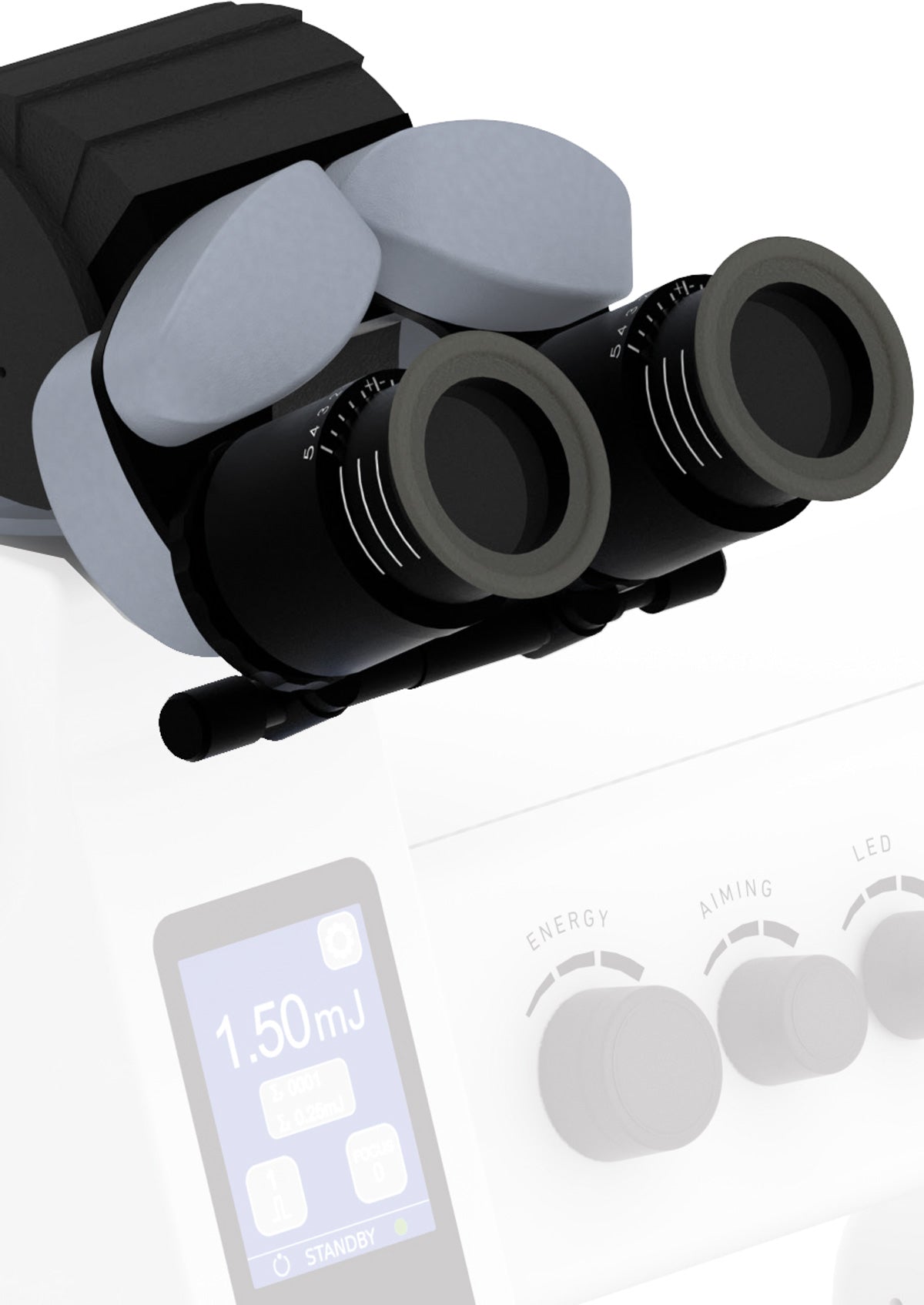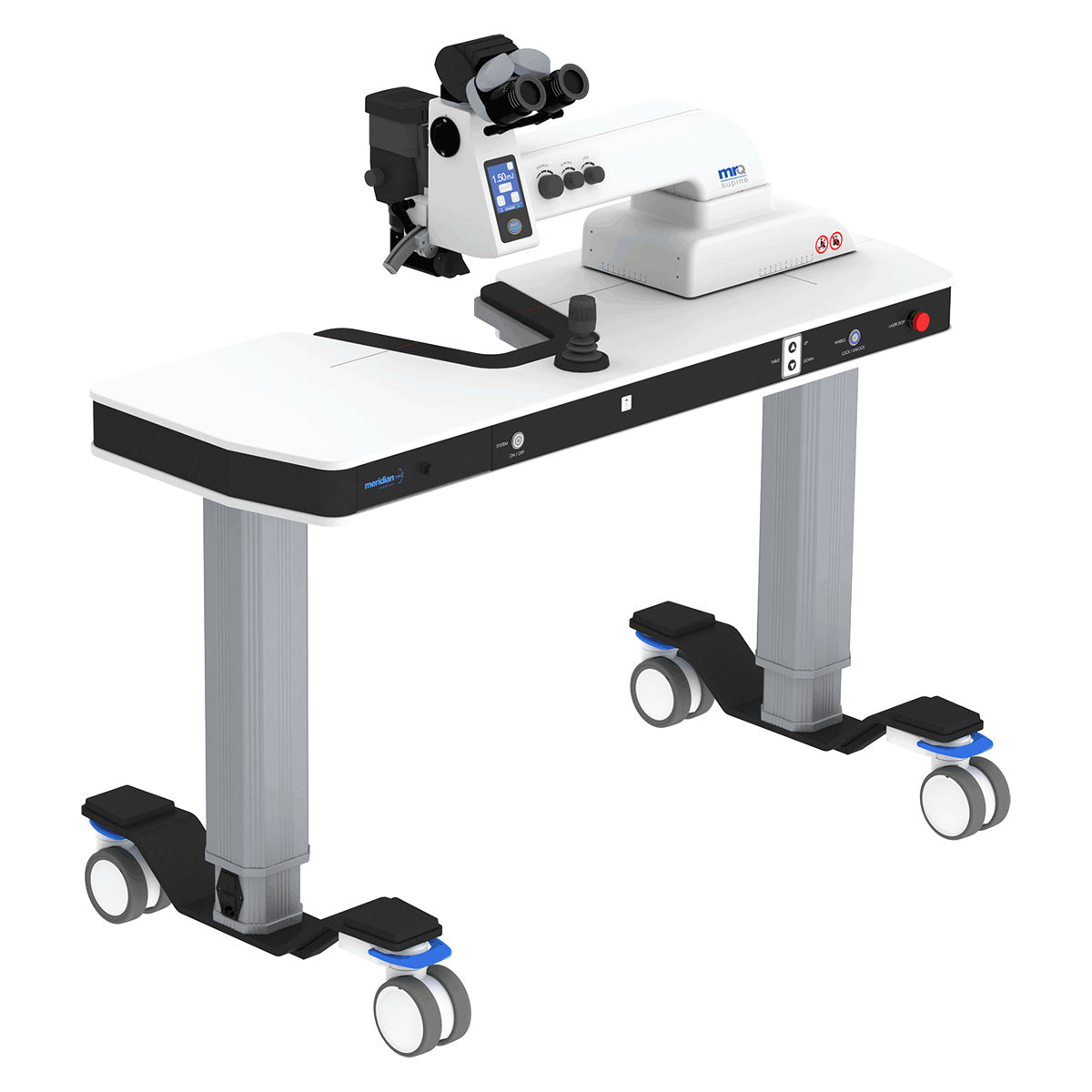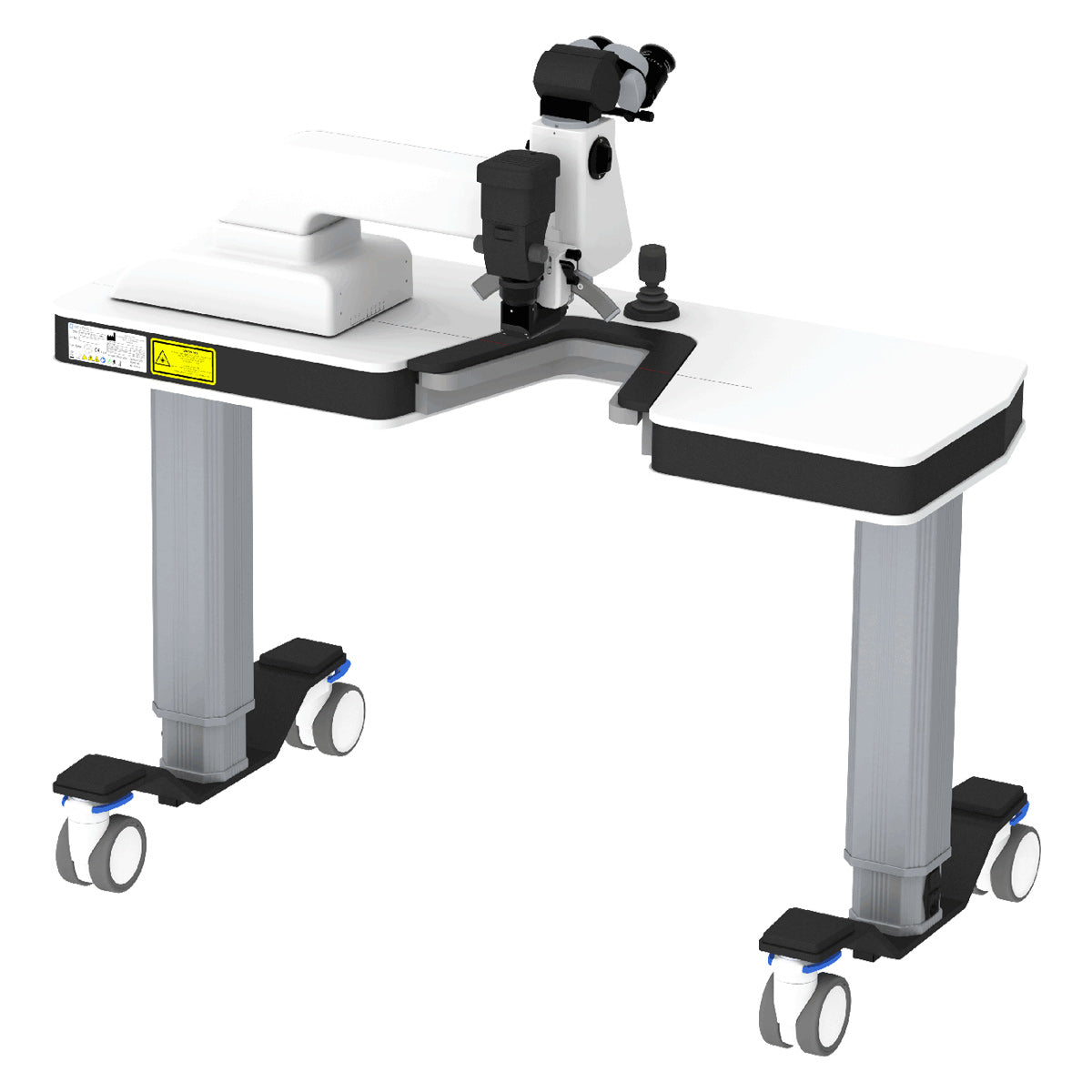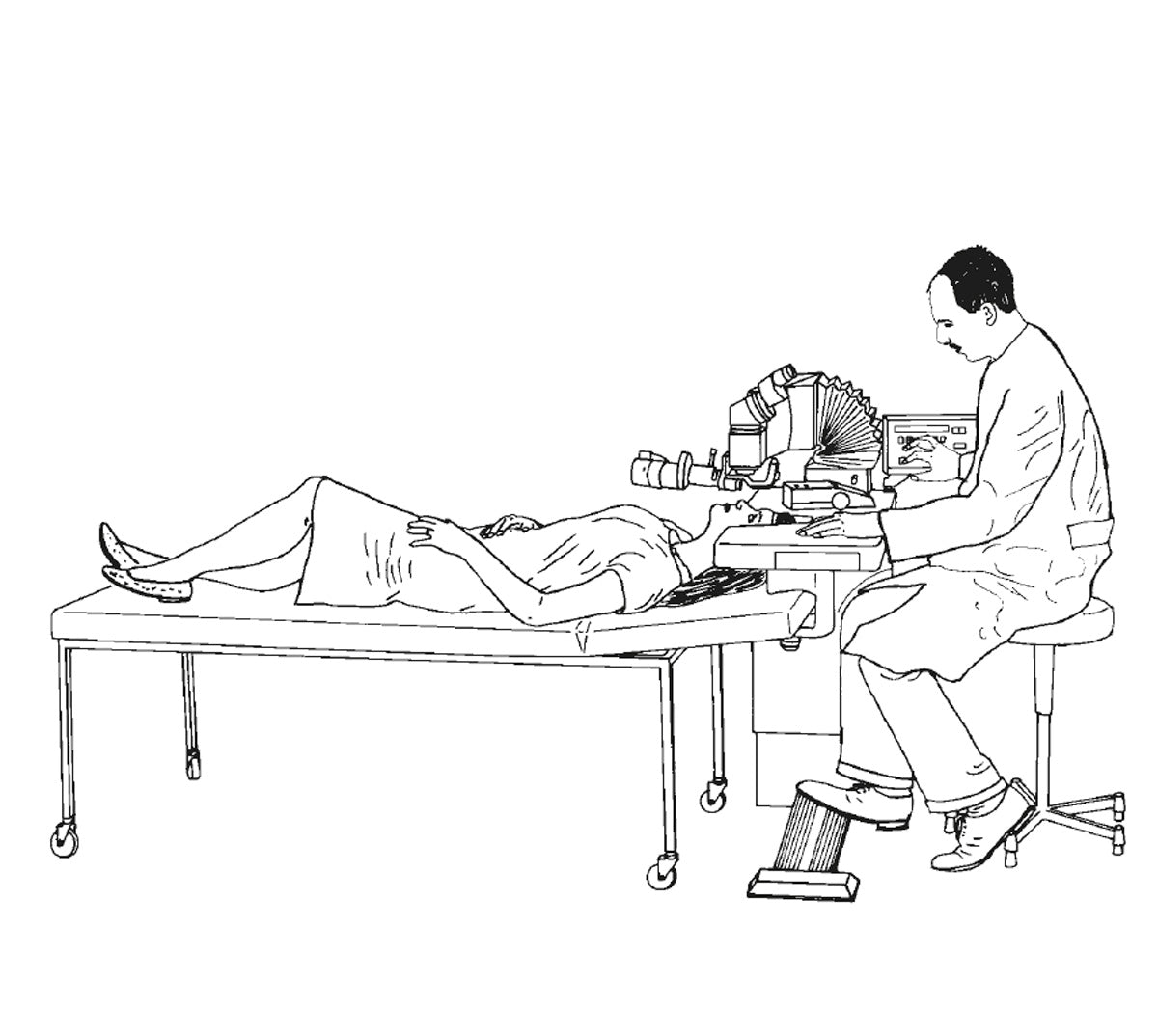Meridian Nd:YAG Laser MRQ YAG Supine
Revolutionizing laser treatments, the MRQ YAG Supine stands as a fully-integrated ophthalmic laser uniquely designed for supine use, making capsulotomy and iridotomy procedures more accessible than ever before. Pioneering a remarkable advancement in patient care, this cutting-edge system is the only one of its kind on the market, offering treatments to patients who are unable to sit at a slit lamp. Its exceptional design makes it an ideal choice for both paediatric and elderly patients, ensuring their comfort and enhancing treatment accessibility.
Embrace the future of ophthalmic care with MRQ YAG Supine, where innovation and patient-centered design unite, transforming treatment possibilities and enhancing the well-being of every patient, one procedure at a time.







At the forefront of innovation, the Meridian Medical MRQ YAG Supine stands as a fully-featured and integrated Nd:YAG laser, expertly combined with renowned European precision optics. Its high-grade aluminium mono-block laser housing exudes a unique solid feeling, ensuring lasting durability and unwavering performance. The MRQ YAG Supine boasts a cutting-edge super Gaussian mode laser profile, delivering unparalleled performance and accuracy during laser treatments. To meet the highest standards, the MRQ YAG Supine undergoes rigorous testing under severe conditions, surpassing expectations and demonstrating outstanding performance. Embrace the pinnacle of reliability and longevity, forging a path towards exceptional patient outcomes and a brighter future in ophthalmic care.

The MRQ YAG Supine emerges as a powerful and fully-featured Nd:YAG laser meticulously crafted to treat patients in a supine position, making it the ideal choice for operation theaters. Its innovative design reshapes ophthalmic possibilities, catering to diverse clinical needs with utmost ease and precision. Enhancing surgeon comfort and providing unparalleled visual quality, the MRQ YAG Supine features ergonomically designed 0 – 210° tiltable Haag-Streit binoculars. This thoughtful design ensures unparalleled comfort during procedures, granting practitioners a clear and unobstructed view for precise treatments. The MR Q Supine introduces unique safety features at every start, boasting digitally controlled anterior and posterior offset. These intelligent safeguards provide practitioners with peace of mind, minimizing risks and ensuring precision throughout every procedure.

Safety remains paramount in every ophthalmic procedure, and the MR Q takes no chances in ensuring the utmost protection for both the patient and the surgeon. With electronically controlled laser movements, practitioners can precisely position the laser with unmatched accuracy, allowing for seamless and controlled treatments.
Embracing cutting-edge technology, the MR Q reimagines key access with an electronic keypad. This user-friendly interface features a 4-pin access code, granting authorized personnel seamless entry to the laser's functionalities. Designed for utmost security and simplicity, this electronic keypad further enhances the safety protocols in a hospital setting, safeguarding against unauthorized usage.
Ensuring precision throughout every procedure, the MR Q features electronically controlled offset capabilities. Surgeons can meticulously control the laser disruption, precisely aligning it with the targeted area. Moreover, audible alarms are emitted when the anterior offset is selected, providing real-time feedback and minimizing the risk of erroneous offset selection. With this advanced safety feature, practitioners can confidently navigate each treatment, knowing that every laser parameter is under their complete control.

The supine treating position proves ideal for pediatric patients, as well as those requiring sedation or unable to sit upright. This unique positioning offers numerous advantages, reducing stress on patients, doctors, and theater staff alike. The MR Q Supine provides a perfect ergonomic laser interaction, ensuring ease and comfort during treatments. Surgeons can focus on delivering precise care with confidence, enhancing the overall treatment experience. Designed to work with any existing operating table featuring a headrest, the MR Q Supine is adaptable to various operating theater requirements. Its versatility extends to include a special fixture for very young patients, ensuring a seamless and comfortable treatment setup.
OPTIMIZE YOUR WORKFLOW
Discover a realm of possibilities with the MRQ YAG Supine, where spa-like luxury meets cutting-edge ophthalmic care. Elevate your practice space with a device that captivates patients and empowers practitioners. Experience the transformative power of innovation, as the MRQ YAG Supine becomes the defining factor that sets your practice apart.
Embrace the Future of Patient Care - Step into a new era of excellence with the MRQ YAG Supine. Redefine your practice space and offer patients an experience they will cherish.





The history of Meridian AG, now known as Meridian Medical Group, is intricately linked to the evolution of medical Nd:YAG lasers. Notably, the Microruptor II, a groundbreaking invention by Meridian engineers and the esteemed Prof. Dr. Franz Fankhauser († 2020), revolutionized numerous ophthalmology treatments, leaving a lasting impact on the field.
Continuous innovation is the lifeblood of our company, as our development engineers persistently create and patent cutting-edge technologies. To guarantee the utmost quality and long-term reliability, we meticulously select and integrate top-notch Swiss and European laser components.
With unwavering commitment, we adhere to tested and reliable best practices in engineering and integration, resulting in peak performance of our systems. Our dedicated and highly skilled staff diligently work to deliver the exceptional service and results that our esteemed customers deserve and have grown to expect from us. At Meridian Medical Group, excellence is not just a goal; it is an inherent part of our DNA.
■ Yearly maintenance service assures the optimal performance of your laser
■ Follow the safety advice of the manufacturer and your regulatory body
■ Only use the laser as described in the IFU
CLINICAL INDICATION For posterior capsulotomy and iridotomy.
These guidelines have been carefully prepared in accordance with industry standards for Nd:YAG treatments. However, it is important to note that the ultimate responsibility for the use of the laser and its parameters lies with the treating ophthalmologist.

Although the MR Q Supine clinical evaluation did not specifically contemplate these parameters, the following treatments are described for Nd:YAG use.


To ensure optimal precision during laser treatments, it is crucial for each user to have the oculars set for their personal refraction. This ensures that the laser is in parfocality with the aiming beam and retina, minimizing any discrepancies. Avoiding a defocused slit lamp is imperative, as it may lead to unpredictable laser burns, which could have adverse effects on the treatment outcome.
PEDIATRIC TREATMENTWhen administering treatment to infants and young patients, it is essential to adjust the power accordingly. The posterior capsules in pediatric patients tend to be softer, necessitating a greater amount of energy to effectively cut the tissue.
ABOUT THE OFFSETLaser energy travels towards the point of emission, which is to the front of the eye. When shooting with a zero-offset, there is an increased risk of lens pitting. To avoid any potential complications, it is essential to always check and set the offset correctly before proceeding with any treatment.

■ Laser safety sign
■ Safety goggles
■ Dust cover
OPTIONAL ACCESSORIES
■ Foot-switch
■ Single port beam splitter
■ Co-observation tube
■ Adapter for ½” digital camera

Click here to see the brochure
| Laser Source | Q-switched Nd:YAG |
| Wavelength | 1064 nm |
| Energy Range | 0.3 – 12 mJ (in single pulse mode), 32 mJ max (in triple pulse model) |
| Pulse Duration |
CW (continuos wave, pulsed) 4 ns (typical) |
| Treatment Spot Size | < 10 μm |
| Burst Mode | 1, 2 or 3 pulses |
| Cone Angle | 16° |
| Treatment Offset |
Electronically controlled, anterior: 150 μm, 300 μm; posterior: 0 μm, 100 μm, 200 μm, 300 μm; |
| Slit Lamp | CS0 9800 LED Zeiss type |
| Laser Repetition Rate | up to 2.5 Hz |
| Aiming Beam | Red diode. Dual beam. 635 nm |
| Triggering | Joystick (footswitch optional) |
| Magnification | 6×; 10×; 16×; 25×; 40× |
| Cooling System | Air cooled |
| Dimensions H ×W ×D | 47 in × 47 in × 28 in |
| Weight | 143 lbs. (unpacked) |
| Power Rating | 520 VA |
| Power Requirements | 220 – 240 VAC 50/60 Hz |
| Patient Position | Supine |
| Laser Source | Q-switched Nd:YAG |
| Wavelength | 1064 nm |
| Energy Range | 0.3 – 12 mJ (in single pulse mode), 32 mJ max (in triple pulse model) |
| Pulse Duration |
CW (continuos wave, pulsed) 4 ns (typical) |
| Treatment Spot Size | < 10 μm |
| Burst Mode | 1, 2 or 3 pulses |
| Cone Angle | 16° |
| Treatment Offset |
Electronically controlled, anterior: 150 μm, 300 μm; posterior: 0 μm, 100 μm, 200 μm, 300 μm; |
| Slit Lamp | CS0 9800 LED Zeiss type |
| Laser Repetition Rate | up to 2.5 Hz |
| Aiming Beam | Red diode. Dual beam. 635 nm |
| Triggering | Joystick (footswitch optional) |
| Magnification | 6×; 10×; 16×; 25×; 40× |
| Cooling System | Air cooled |
| Dimensions H ×W ×D | 47 in × 47 in × 28 in |
| Weight | 143 lbs. (unpacked) |
| Power Rating | 520 VA |
| Power Requirements | 220 – 240 VAC 50/60 Hz |
| Patient Position | Supine |


















































